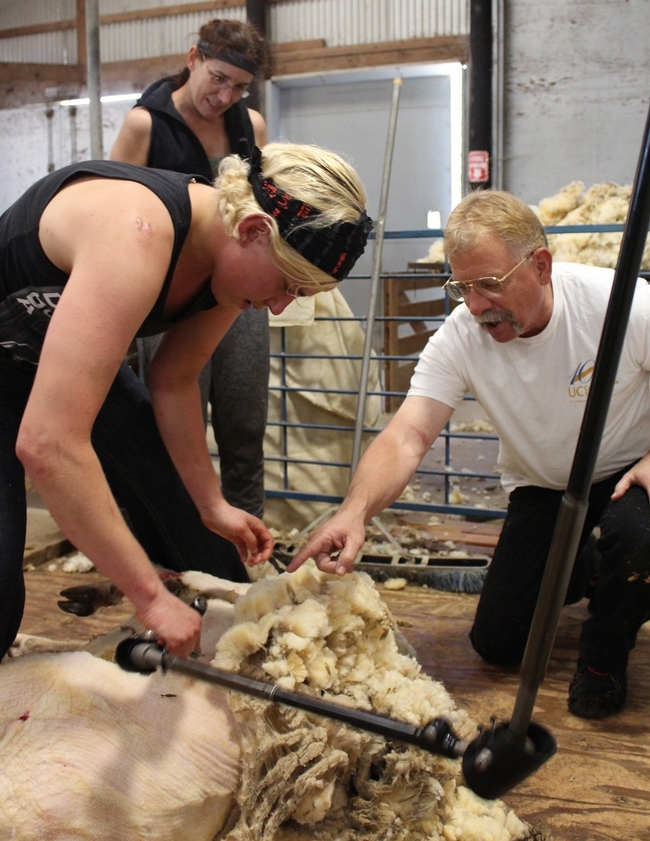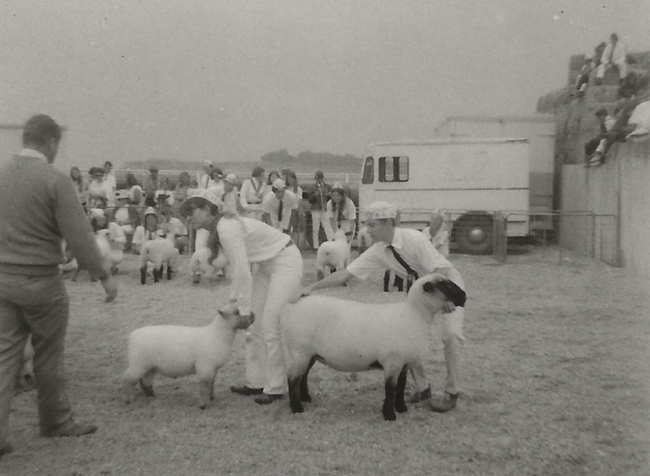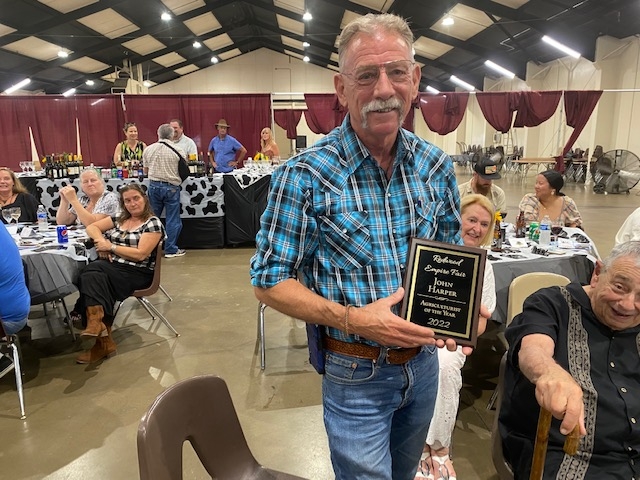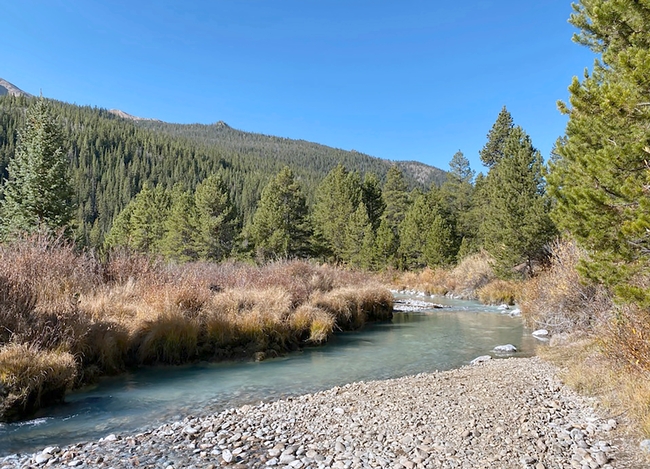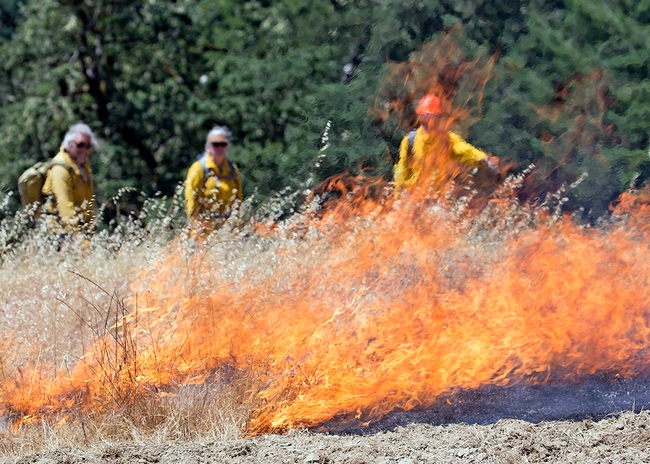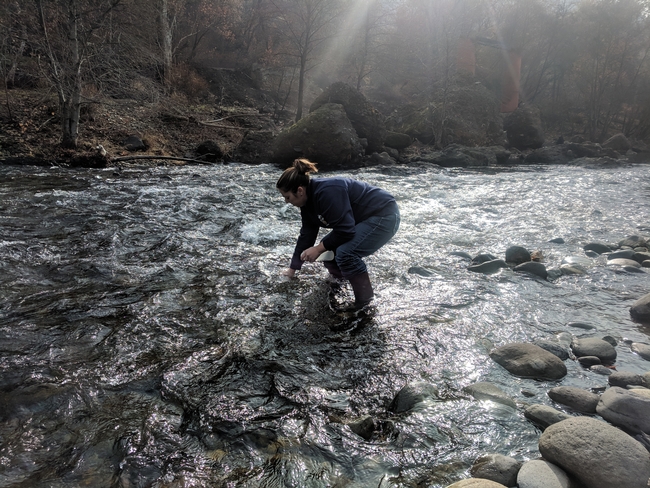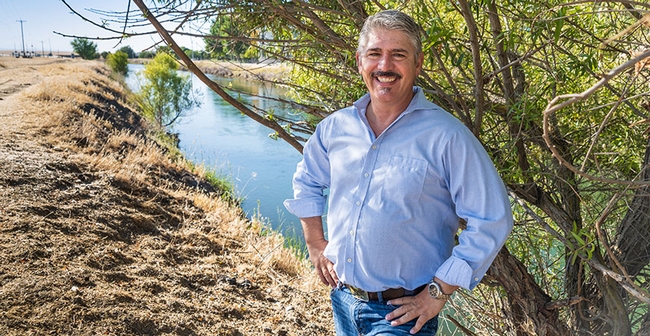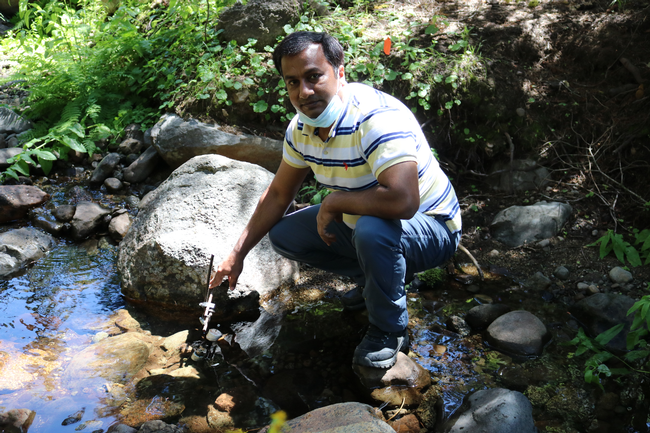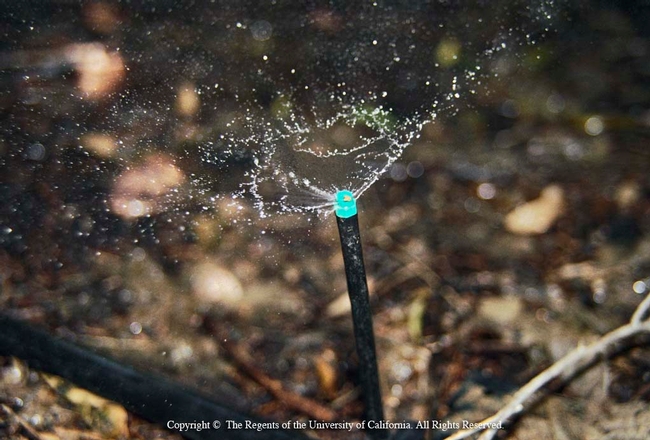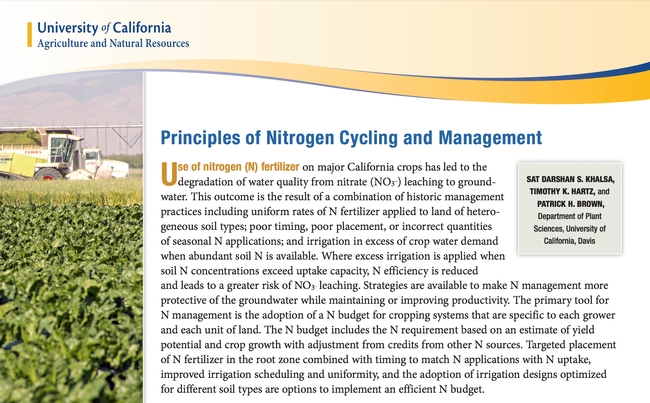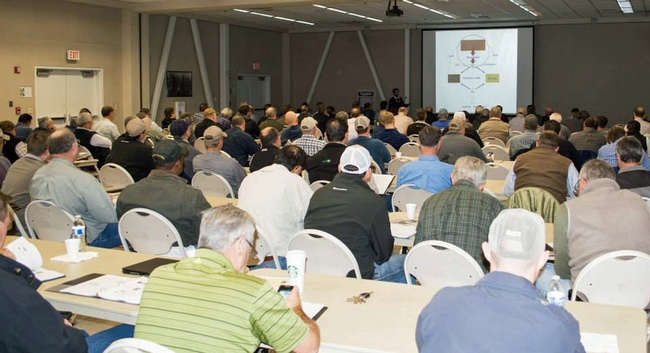
Posts Tagged: Water Quality
Shearing students, ranchers flock to livestock advisor Harper
UCCE livestock advisor John Harper retires after 32 years
"If you know how to shear, you'll never be poor," Stephany Wilkes remembers John Harper, University of California Cooperative Extension livestock and natural resources advisor for Mendocino and Lake counties, telling her sheep shearing class in 2013.
“He was speaking to everyone, of course, but he really spoke to me: being poor (again) is one of my greatest fears and I've avoided it at all costs,” Wilkes said. Harper's words and a certificate from the course gave her the confidence to leave Silicon Valley for greener pastures.
“Eleven years later, with a successful business and published book about shearing to boot, I can confirm John does not lie to his students,” says the former software developer. “More than that, he is encouraging, calm, respectful, experienced, honest, funny and an excellent storyteller. If not for John, I would not have the life I live today.”
Today, Wilkes is a sheep shearer, knitter and author of “Raw Material: Working Wool In the West.”
Harper officially retired July 1, 2023, after 32 years in his UC Cooperative Extension advisor role, but returned to serve as interim director of UCCE for Mendocino and Lake counties until Matthew Barnes was hired on May 1.
For years, UCCE has offered the only five-day sheep shearing school in California, training 15 to 28 students annually, and Harper has been the force behind it.
“Most of the shearers now in the shearing business in California were trained by me and my fellow instructors,” said Harper, the state's Ed Sheeran of sheep shearing.
He first offered the sheep shearing school in 1993 at the Paul and Kathy Lewis ranch in Upper Lake, with subsequent schools at the Stanley Johnson ranch in Booneville. In the early days, Harper brought in instructors from New Zealand, before he and Mike McWilliams, a former member of the USA Sheep Shearing Team, began teaching. Later Harper moved the school to UC Hopland Research and Extension Center, where he has hosted the school for the past 27 years.
With grant funds from the National Sheep Industry Improvement Association, Harper bought shearing equipment and made seven portable shearing pens to offer shearing school at a private ranch in Clear Lake Oaks this year.
“This program is nationally and internationally known and there is a waiting list of over 1,000 people who want to take it,” Harper said.
Harper's baa-ackground in 4-H
Growing up on his family's farm in Yucaipa, just east of San Bernardino, Harper's electrical engineer father gave him a choice between caring for the horses' hooves and shearing sheep. “I chose shearing since I wasn't very big and didn't like horses leaning on me,” he said.
From age 9 to 19, he was active in the California 4-H Youth Development Program, achieving the Gold Star rank. “I was in 4-H with sheep, horses, veterinary medicine, tractor, electrical, welding and woodworking projects,” said Harper, who won the outstanding junior leader award. “I was a junior leader in sheep and won the state award for my sheep project. I showed registered Hampshire sheep, and my flock grew to 50 ewes before I was done.”
“Shearing sheep helped me pay for college,” said Harper, who earned a master's degree in range management at the University of Arizona and a bachelor's degree in animal science and agricultural economics at UC Davis.
After college, Harper worked as an assistant manager on the PolyPay breed development at Nicolas Sheep Farms in Sonoma before starting a career in Cooperative Extension in Arizona.
When Harper joined UC Agriculture and Natural Resources in 1991, the internet was in its infancy, but he recognized its potential for sharing information. He learned how to write code and created the university's first websites for livestock and natural resources. He also was an early adopter of blogging, Facebook, LinkedIn and Twitter to extend information, which earned him a silver award in 2011 from the Association of Natural Resources Extension Professionals.
Beyond shearing, Harper pioneered cutting-edge research
Although sheep are more photogenic on social media, Harper has been flooded with awards and accolades for his water quality research.
Informed by research from Harper, Lake County rancher Russ Rustici created the first rangeland water-quality ranch plan in the state. Rustici was so pleased that he donated research funding for the entire UC Rangeland Watershed Program team and later established two endowed chairs at UC Davis and one at UC Berkeley. The Rustici Endowment now provides research and education grants for rangeland and cattle efforts.
In 1995, Harper and his UCCE colleagues began teaching the Rangeland Water Quality Planning Short Course to help land managers develop water-quality management plans for their ranches to prevent water pollution. By 2015, they had taught more than 80 of these short courses, reaching more than 1,000 ranchers in 35 counties, representing over 2 million acres statewide. In one follow-up survey, 68% of the participants said they had implemented practices on their ranches to protect or improve water quality.
In 2012, the Western Extension Directors Association presented Harper with its Award of Excellence for the Rangeland Watershed Program.
Eating between the vines
For one livestock research project, he and UCCE colleagues trained sheep to graze the grass in vineyards and not eat the grapevines. “The results went viral internationally and really brought targeted grazing to the forefront,” Harper said. “It also raised sheep number by 2% in our two counties.”
In addition to advising ranchers and teaching sheep shearing, Harper has served in several leadership positions, rotating in every few years as UCCE director in Mendocino and Lake counties. From 2014 to 2017, he led UC ANR's Sustainable Natural Ecosystems Strategic Initiative, advocating for the hiring of experts in climate change, economics, small ruminants, forestry and fire.
“I'm especially proud that we were able to recruit a small ruminant extension veterinary specialist – a position that was unfilled for over seven years, despite California being the second-largest sheep-producing state in the nation,” Harper said.
The certified rangeland manager and rangeland professional has long been a member of the Society for Range Management and the American Society for Animal Science. In 2008, he served as president of the California-Pacific Section of the Society for Range Management. Currently he is the secretary/treasurer for the Mendocino/Lake Wool Growers Association and is ad hoc director of the Mendocino/Lake County Cattlemen's Association.
In 2015, the Society for Range Management gave him the Outstanding Achievement Award-Stewardship. In 2017, the California Wool Growers Association bestowed on him its Golden Fleece Award for Lifetime Achievement. In 2019, Harper was named Range Manager of the Year by the California-Pacific Section of the Society for Range Management for his contributions to the profession. In 2022, the 12th District Agricultural Association Redwood Empire Fair honored him with their Mendocino County Agriculturalist of the Year Award.
Harper also received UC Agriculture and Natural Resources' prestigious emeritus status. In retirement, he plans to play his banjo and continue offering the sheep shearing school with GaryVorderbuggen, who has been teaching with him for 18 years. Randy Helms, a former member of the USA Sheep Shearing Team, and Harper's former students Matt Gilbert, Lora Kinkade and Wilkes are among those who have re-ewe-nited with him as sheep shearing instructors.
“John taught the UCCE sheep shearing schools I attended in 2013-2015, and I was deeply honored to teach beside him in 2023 and 2024. It is one of the highlights of my life,” said Wilkes, now better known for working with wool than developing software.
“Like so many past students, I am forever in his debt,” she added. “We've got to keep this shearing school you started going, John. It is a gift. Thank you.”
How can California protect its water supply from wildfire?
Stakeholders from across disciplines and institutions offer recommendations to ensure safe, reliable water supply amid a growing wildfire threat
It's intuitive that wildfires can affect ecosystems, harm wildlife and contaminate streams and rivers. But wildfires can also have complex, severe and direct effects on our water supply and infrastructure — effects that have only become clear in recent years. Scientists and policymakers must integrate insights and experience from many disciplines and sectors to understand and address the consequences.
In September, 23 scholars and practitioners with a diversity of water and fire expertise came together to answer a critical question: How can California proactively protect its water supply from fires? Their findings, combined with the insights of the author team, form the basis of a new scoping report, released by the University of California Division of Agriculture and Natural Resources' California Institute for Water Resources and the UCLA Luskin Center for Innovation.
“Different people have different pieces of the puzzle, but it's really hard to put them together. That is why we assembled this cross-sector group,” said Faith Kearns, academic coordinator at the California Institute for Water Resources.
Illustrated by the 2017 Tubbs Fire in Wine Country, it has been recognized that community water systems face effects that last long after the fire is quenched. For example, Boulder Creek residents in Santa Cruz County still did not have reliable water access more than a year after firefighters extinguished the 2020 CZU Lightning Complex Fire.
“This is truly an emergent issue,” said co-author Peter Roquemore, project manager at the Luskin Center for Innovation. “We have only seen wildfires directly affect community water systems in the past few years.”
To help California policymakers, researchers, affected communities, and water system operators understand the complex relationship between wildfire damage and water supply, the report authors and participants in this workshop present a set of recommendations:
- Make communications more accessible, consistent and trustworthy. Residents must receive timely, unified messaging, translated into appropriate languages and in accessible venues, telling them if their water is unsafe and how to access clean water.
- Invest in local capacity and expertise. The challenges faced vary widely for different communities, and it is important to provide each community with the resources it needs to address the risk it faces. As part of this, efforts should support Indigenous leadership, knowledge and practices to help manage healthy ecosystems.
- Provide guidance to update regulations. Guidance such as building codes and infrastructure regulations will help individuals and communities make informed decisions and address risk appropriately.
- Conduct research and build a broader base of knowledge. There is still much to learn, and it is important to illustrate the exact challenges water systems face and how best to address them.
- Make funding accessible and targeted. Increased earmarked funding for emergency water supplies, housing assistance, and support for water systems, local organizations, and others will help advance solutions.
- Further coordinate efforts to address water and fire issues. Focusing on these interconnected issues together, rather than tackling them separately, can lead to substantial benefits.
To read the specific recommendations identified, read Wildfire and Water Supply in California. Funding for this research was provided by the U.S. Geological Survey through the California Institute for Water Resources.
UC Merced leads innovative effort to secure water for agriculture and ecosystems
UC Merced's largest research grant in its 16-year history aims to improve agricultural and environmental water resilience. The new $10 million collaborative focuses on water banking, trading and improvements in data-driven management practices to arrive at a climate-resilient future in water-scarce regions of the United States.
The U.S. Department of Agriculture announced it is funding the wide-ranging effort from multiple institutions across three states through its National Institute of Food and Agriculture's Agriculture and Food Research Initiative on Sustainable Agricultural Systems. The coalition of researchers is led by UC Merced, joined by experts from UC Berkeley, UC Davis, UC Agriculture and Natural Resources, Utah State University, the New Mexico Water Resources Research Institute at New Mexico State University, the Public Policy Institute of California, Environmental Defense Fund, and the U.S. Geological Survey's Southwestern Climate Hub.
“There are a lot of challenges in balancing the needs of agriculture and ecosystems, and climate change and drought are only exacerbating difficult decisions about how to sustain water resources,” lead project director UC Merced Professor Joshua Viers said. “But our team of advisors, educators and scientists are eager to enable data-driven decision-making for securing a climate resilient future for our water-stressed regions.”
The partners in the USDA funded collaboration — Securing a Climate Resilient Water Future for Agriculture and Ecosystems through Innovations in Measurement, Management and Markets or SWIM — will focus on developing more robust, data-driven information systems for decision-makers such as land and water managers. SWIM is designed to provide objective measures of supply and demand, and incorporate drought forecasting and climate change trends.
The research and extension team, by working with local decision-makers, will improve the accuracy of measurement in water budgets, evaluate novel management strategies such as on-farm aquifer recharge, and evaluate water trading and markets to improve sustainable surface and groundwater use.
The SWIM project will work across disciplines and stakeholders, integrating research, extension and education in three testbeds with unique water policies and systems: Cache Valley, Utah; Mesilla Valley, New Mexico; and the San Joaquin Valley. All of them grow orchard crops and alfalfa, and all are in a drought. Like California, Utah is experiencing an unprecedented drought, where 99 percent of the state is in extreme or exceptional drought. And, like California, the physical and cultural geography of New Mexico is extremely diverse. Exploring all innovative avenues of water management is necessary for sustaining a future for agriculture and surrounding communities while balancing ecosystem needs across the west, Viers said.
SWIM's leadership plans such activities as workshops and field days to actively engage stakeholders, including the extension-grower networks of each state's university system, as well as land, water and ecosystem managers.
Researchers from UC Merced include Viers, professors John Abatzoglou, Tom Harmon, Teamrat Ghezzehei, Josué Medellín-Azuara and Colleen Naughton, UC ANR Extension Specialist Safeeq Khan, Chelsea Arnold, who oversees the CalTeach program through the School of Natural Sciences, and researchers Leigh Bernacchi, Max Eriksson and Nicholas Santos.
“The SWIM project aims at bringing the sustainability science from ‘silos' to impact by systematically engaging our stakeholders and clientele in the knowledge co-production and systems thinking,” said Khan, UC Cooperative Extension specialist in water and watershed sciences.
“The project will build on the existing work of UC ANR networks and academics in understanding the needs of growers, irrigation districts, and ecosystem managers and co-developing data and tools to help adopt and adapt climate-resilience strategies. Our emphasis is not only on producing science and decision-support tools, but also using the project as an opportunity for social learning, knowledge empowerment, science communication, and workforce development through extension and outreach.”
In addition to ongoing activity at UC ANR's Kearney Research and Extension Center, one of the testbeds in California will be the new UC Merced Experimental Smart Farm. Researchers will collect soil, water and crop data, track droughts, conduct water accounting and life-cycle assessments, and produce user-focused data and analysis there and in the other two regions.
“The western United States is experiencing declining surface water and groundwater, adding stress on all aspects of the social-hydrological system,” said co-investigator Sam Fernald, director of the New Mexico Water Resources Research Institute at New Mexico State University. “The lessons learned in this project will offer a blueprint for addressing future water challenges, not just in the West, but other locations worldwide facing similar water shortage issues.”
The researchers want to answer many pressing questions, such as how much the changing characteristics of multi-year droughts alter people's willingness to engage in water trading and banking as part of climate resilience efforts; whether drought early warning systems propel water trading; how ecosystem services can be maintained while adapting agricultural water management to anticipated extremes; what are the key drivers and barriers adopting or participating in water markets; and how new data and technology can reduce costs and barriers.
They will also look at how climate change impacts can be mitigated through a rainy-day storage option called managed aquifer recharge or MAR, as well as water trading at multiple scales and land-use planning so that agriculture and the environment can be sustained.
One key component of creating a sustainable future is through educational programming, one of the core activities of the grant. The Climate Adaptation Science Academy will give affiliated graduate students the jump on their careers as leaders in science and engineering by providing training in climate adaptation science, communications and complex systems problem solving.
“Expanding the reach of our program are transformational K-12 educational tools,” Viers said. “Educators and graduate students will develop curricular materials for AgSTEM education pathways reaching from rural, regional middle schools to the teachers serving underrepresented groups.”
The SWIM team plans to develop such tools as games that support computational thinking and decision-making, activities in which students learn about agriculture and careers in smart farming, and hands-on experiential learning.
As associate dean for research in the School of Engineering and the director of the campus's branch of the Center of Information Technology and Research in the Interest of Society (CITRIS and the Banatao Institute), Viers discussed the role of UC Merced in providing tangible solutions to pressing societal problems:
“It has been clear for some time that water scarcity is our new reality, and we know we need to do things differently,” he said. “This research award is the largest that USDA makes to universities, and it is clear that they believe UC Merced and our affiliates are the right team with the right ideas to help secure a climate resilient water future.”
Originally published at https://news.ucmerced.edu/news/2021/uc-merced-leads-innovative-effort-secure-water-agriculture-and-ecosystems.
UC ANR publishes nitrogen management advice for fruit, nuts and other crops
California growers can download a new series of publications summarizing efficient nitrogen management practices from UC Agriculture and Natural Resources. The publications are designed to assist growers in complying with state regulations for tracking and reporting nitrogen fertilizer applied to crops, in an effort to prevent nitrogen from leaching into groundwater.
The science-based publications are associated with a series of trainings for growers and Certified Crop Advisers to develop efficient nitrogen management practices, an effort coordinated by UC ANR's California Institute for Water Resources.
“Our role is to provide farmers, agricultural consultants and policymakers the best science possible for making decisions on managing and protecting California groundwater,” said Doug Parker, director of the water institute.
The free publications, created from training materials, lessons learned from the training sessions and from additional UC research, can be downloaded at http://ucanr.edu/nmgmtpublications.
The following publications are now available for download:
· Principles of Nitrogen Cycling and Management
· Irrigation and Nitrogen Management
· Nitrogen Management for Nut Crops
· Nitrogen Management for Deciduous Fruit and Grapes
· Nitrogen Management for Citrus and Avocado
· Nitrogen Management for Cool-Season Vegetables
· Nitrogen Management for Strawberry Production
· Nitrogen Management for Processing Tomato
· Nitrogen Management for Corn on California Dairies
The publications were authored by Parker of California Institute for Water Resources; Patrick Brown, professor in the UC Davis Department of Plant Sciences; Allan Fulton, UC Cooperative Extension advisor, Tehama County; Tim Hartz, UC Cooperative Extension specialist emeritus, UC Davis Department of Plant Sciences; Dan Munk, UC Cooperative Extension advisor, Fresno County; Daniel Geisseler, UC Cooperative Extension specialist, UC Davis Department of Land, Air & Water Resources; Michael Cahn, UC Cooperative Extension advisor, Monterey, Santa Cruz and San Benito counties; Richard Smith, UC Cooperative Extension advisor, Monterey, Santa Cruz and San Benito counties; Marsha Campbell, UC Cooperative Extension advisor emeritus, Stanislaus County; Sat Darshan Khalsa, UC Davis project scientist; and Saiful Muhammad, UC Davis graduate student.
Developed in 2014, the training program has been offered at 11 different locations around the state, most recently in Fresno. More than 1,000 Certified Crop Advisers have taken the training.
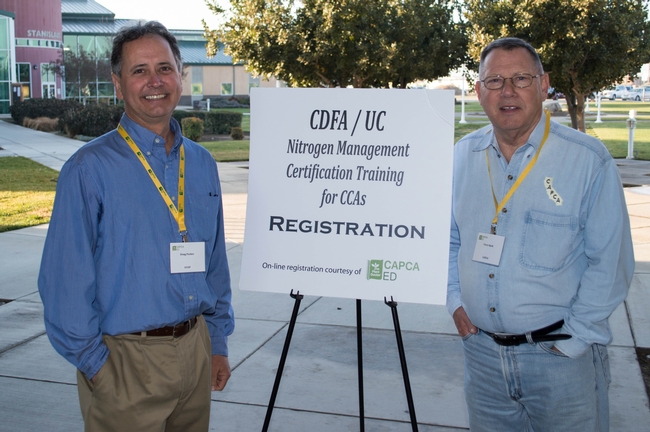
The nitrogen management training curriculum was developed by a group of UC ANR faculty, specialists and advisors. The first day focuses on the nitrogen cycle in crop production systems, nitrogen sources, irrigation and nitrogen management, and nitrogen budgeting. The second morning covers annual and permanent crops and nitrogen planning practices.
For more information on the nitrogen management training materials, visit http://ciwr.ucanr.edu/NitrogenManagement.
The Nitrogen Management Training and Certification Program is a joint effort between the California Department of Food and Agriculture, UC Agriculture and Natural Resources, California Association of Pest Control Advisers' Certified Crop Adviser Program and the Regional Water Boards.
Impact of Controlling Yellow Starthistle on Watershed Runoff and Groundwater Levels
Yellow starthistle (Centaurea solstitialis) (YST) is the most pervasive invasive and noxious weed...

